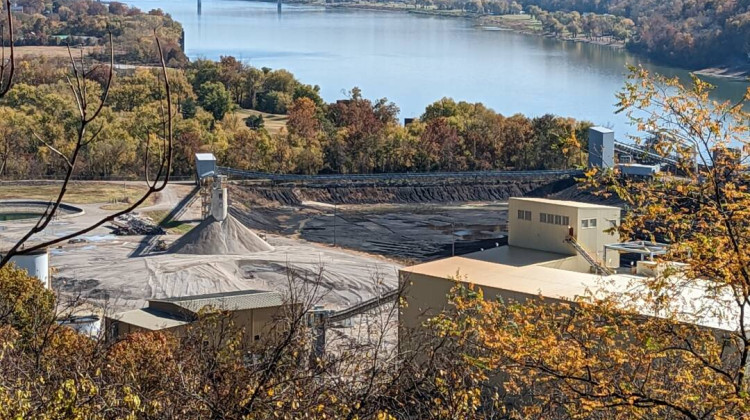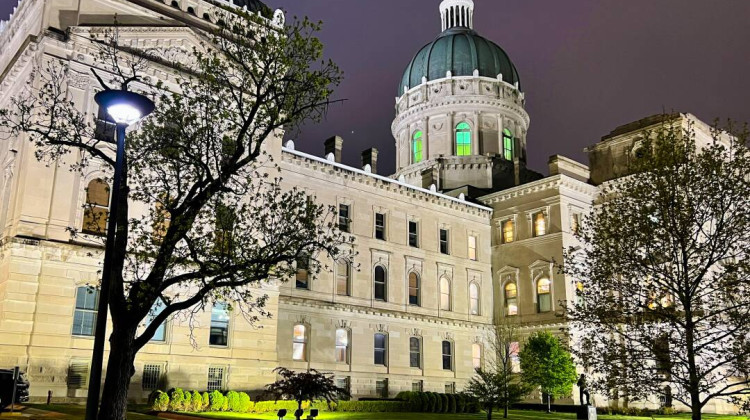
According to AAA, South Bend gas prices are currently averaging around $4.14 a gallon, up from $3.54 a month ago and $2.61 a year ago.
Jakob Lazzaro/WVPEJonah has driven for Doordash for four years and Amazon Flex — Amazon’s package delivery service — for about 10 weeks.
At the start of the pandemic, he said he was making $30 to $35 an hour, sometimes even as high as $40 an hour.
“Like, I didn’t want to stop working — I didn’t want to leave my car,” Jonah said.
The 23-year-old, who requested I only use his first name, said gig work was nice because it was flexible — he’s also taking online classes for a degree in business administration.
Jonah mostly drives for Amazon now, putting in about 1,500 miles a month, because it’s been the best way to make money. For example, Amazon Flex will pay him about $100 for a three-and-a-half-hour shift delivering packages.
But that income really fluctuates.
“I try not to move my car unless I’m making a minimum of $25 an hour,” Jonah said.
A month ago, he made $1,200 in one week. But the week we talked, he had only made $400.
That’s because ever since Russia invaded Ukraine, Americans have watched gas prices skyrocket — and people who deliver for apps like Uber Eats, Doordash or Amazon Flex have been hit especially hard.
“It’s actually biting into a sizable chunk of what you make,” Jonah said.
Amazon has started sending its in-house van drivers on the shorter routes and giving the longer, rural ones to Flex drivers — effectively passing on the higher fuel costs.
<img alt="Jonah completed this Amazon Flex route, a 64-mile one-way trip from South Bend, the same day as our interview. The route contained three packages, and he was paid $63 — less than 50 cents per mile when including the return trip to South Bend. Via text, he said, “they’ve never sent us this far before” and that he saw two drivers “who just flat out refused to take their routes as well, which never happens at our distribution center." "="" data-caption="Provided / Jonah" data-description="Jonah completed this Amazon Flex route, a 64-mile one-way trip from South Bend, the same day as our interview. The route contained three packages, and he was paid $63 — less than 50 cents per mile when including the return trip to South Bend. Via text, he said, “they’ve never sent us this far before” and that he saw two drivers “who just flat out refused to take their routes as well, which never happens at our distribution center." data-cke-saved-src="/files/image/amazonflex-route-sized.png" src="/files/image/amazonflex-route-sized.png" style="width: 100%;">
At the same time, he said Amazon has lowered pay for Flex drivers.
“A few weeks ago, Amazon’s base rate for South Bend drivers was $23 an hour,” Jonah said. “They lowered those base rates to $21 an hour, and they have a whole influx of new drivers.”
Amazon spokesperson Kelly Nantel said in an emailed statement that the company’s delivery partners “play an important role” in serving customers, and that Flex drivers “earn over $26 per hour on average.”
But Jonah said those high gas prices coupled with the amount of new drivers means there is less work — and profit — for everyone.
“I feel like from the corporate level, it does kind of feel predatory,” Jonah said. “They could definitely give us a fair market value while still taking home a great amount of money.”
He said it would be nice if he was paid a livable wage but does not “think that’s very prevalent in the gig economy.”
“That’s why a lot are advertised as part time jobs, do it on the side,” Jonah said. “But if everyone was just doing it part time, they wouldn’t be getting what they need done.”
So, he’s moving back in with his parents in New York City. It’s something he was planning on doing eventually, but his decreasing income accelerated the decision.
He’s got about a year left in classes for his university degree and isn’t sure what he wants to do next. But he said he’s looking for “structure and stability,” something he “obviously” would not find with gig work.
According to AAA, South Bend gas prices are currently averaging around $4.14 a gallon, up from $3.54 a month ago and $2.61 a year ago.
Rachel Blakeman, the director of Purdue University Fort Wayne’s Community Research Institute, said that matches up with Midwest data from the Bureau of Labor Statistics.
According to that data set, gas prices from February 2021 to February 2022 increased by 34.5 percent.
Blakeman said that’s a “significant jump,” and that it’s difficult for people and companies to absorb.
Gas prices have been higher in the past — for example, in 2008 — but Blakeman said that was an outlier when compared to the cost of everything else, something that’s not true today thanks to inflation.
In early March, the Department of Labor announced the annual inflation rate for February was 7.9 percent, the highest since 1982.
“You need to be about 60 years old to remember inflation in any measurable way back in the early 1980s,” Blakeman said. “For many of us, this is our first time experiencing this kind of inflationary pressure across the board.”
And those increased costs are also impacting Ryan Warinner.
He used to work full-time as a massage therapist, but his hours were cut way back during the pandemic, so he started driving for Uber Eats about six months ago to make ends meet.
At the time, he could consistently pull in an extra $300 to $400 a month, working about 12 hours a week during the lunch and dinner rushes.
On a good night, he can earn $16 to $18 an hour. But when it’s slow? It’s closer to $8 an hour before taxes and expenses.
“I would say over the last few months — and this month in particular — the income has definitely come down,” Warinner said.
Higher gas prices mean he’s paying nearly twice as much to fill up his car than in January. And in response, he’s driving less.
Uber Eats drivers only get paid while delivering an order, and it’s now easier to actually lose money by accepting a delivery because of the distance traveled.
“If you take an order way out there, you’re basically eating the cost of coming back to a hot spot to get another order,” he said. “Up front it looks like a good deal, but when you start looking at it a little closer, you realize ‘OK, I’m going to lose money on this.’”
In response to higher gas prices, Uber introduced an additional payout of 55 cents per delivery. But that payout is the same whether the delivery is one or five miles, and it’s also a little less than the federal mileage reimbursement rate of 58.5 cents.
“It felt like a slap in the face, especially because I just started another job doing home health for physical therapy — so driving to the patient’s home,” Warinner said.
There, he gets reimbursed 55 cents per mile, with an additional 30 cents per mile for the next 60 days in light of the high gas prices.
And he’s an employee — not an independent contractor — getting paid a flat rate of $40 per visit, which works out to about $35 an hour.
Warinner said Uber helped him cover expenses and put food on the table when his hours were cut. But with his new job and the declining pay, he doesn’t see a reason to continue putting in the extra work.
“For people like myself where it’s not necessary anymore, there’s still an appeal to do it because of the flexibility — but at the end of the day, it just needs to be worth it,” Warinner said. “I might as well just actually enjoy my time and reduce the wear and tear on my vehicle.”
To get him back, he said Uber should “take care of its drivers.”
“Employees are not putting up with this kind of stuff anymore,” Warinner said. “Without your drivers, you guys have nothing. Increase the upfront reimbursement to your drivers, do better about reimbursements right now for the mileage.”
But the opposite is true for Tom Russell — despite higher gas prices, he plans to keep driving. The difference? He delivers full-time for DineIn, a local company that only serves Michiana.
He’s driven for the company for the past 21 years. At the start of the pandemic, he was working 60 to 70 hours a week. Now, he’s cut back to around 40 hours.
A typical day means he’s driving 100 to 150 miles.
“I’ve driven just about everywhere you can think of at this point,” Russell said.
Russell is still an independent contractor, but he’s usually earning around $26 or $27 an hour — that’s made up of a delivery fee per order, which scales based on distance, and tips.
With higher gas prices, his profit has gone down — but he said he’s still making a decent income.
“I always look at the bigger picture of these things,” Russell said. “Because me working for DineIn for so long, I’ve seen the peaks and valleys of gas prices.”
Because he’s still making money — and unlike Warinner and Jonah — Russell said he doesn’t plan to stop driving any time soon.
“We have to ride this thing out, let it go,” he said. “And I choose not to focus on the things I cannot control.”
Contact Jakob at jlazzaro@wvpe.org or follow him on Twitter at @JakobLazzaro.
If you appreciate this kind of journalism on your local NPR station, please support it by donating here.
 DONATE
DONATE






 Support WFYI. We can't do it without you.
Support WFYI. We can't do it without you.